 BMW R 1250 GS GSA - Rider's Manual > Tire pressure control (TPC/RDC)
BMW R 1250 GS GSA - Rider's Manual > Tire pressure control (TPC/RDC)
- with tire pressure monitor (TPM) OE
Operation
A sensor located in each tire monitors the air temperature and the inflation pressure inside the tire and transmits this information to the control unit.
The sensors are equipped with a centrifugal controller, which does not enable the transmission of the measured values until the minimum speed is exceeded for the first time.
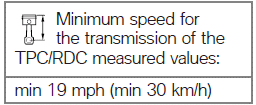
Before initial reception of the tire pressure, -- is shown in the display for each tire. The sensors continue to transmit the measured readings for some time after the vehicle comes to a stop.
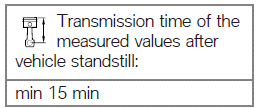
If an TPC/RDC control unit is installed but the wheels have no sensors, a fault message is generated.
Tire inflation pressure ranges
The TPC/RDC control unit distinguishes between three inflation pressure ranges matched to the motorcycle:
- Tire pressure within the permissible tolerance
- Tire pressure within the limit range of the permissible tolerance
- Tire pressure outside of the permissible tolerance
Temperature compensation
The tire inflation pressure is temperature dependent, i.e. it increases or decreases together with the tire air temperature. The tire temperature is dependent on the outside temperature, the riding style and the length of the journey.
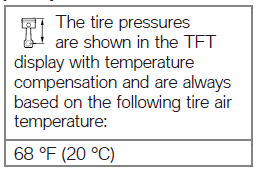
Tire pressure gages at gas stations do not make any adjustment for the air temperature, the tire pressure indicated depends on the temperature of the air in the tire. As a result, in most cases the values displayed there do not match the values shown in the TFT display.
Tire pressure adjustment
Compare the TPC/RDC value in the TFT display with the value on the back cover of the operating instructions. The difference between the two values must be compensated with the tire inflation pressure tester at the filling station.
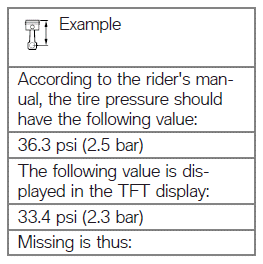
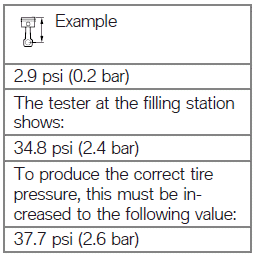
Shift assistant
- with riding modes Pro OE
Shift assistant Pro
Your motorcycle is equipped with a Pro gearshift assistant originally developed for racing but now specially adapted for touring use.
It allows you upshift and downshift under almost any load conditions and in virtually all enginespeed ranges without operating the clutch or accelerator.
Benefits
- 70-80 % of all gear changes can be performed without using the clutch.
- Less movement between pilot and pillion due to shorter gearchange intervals.
- Throttle does not have to be closed when changing gear under acceleration.
- During deceleration and downshifts (throttle plate closed) the system blips the throttle to obtain the correct engine speed.
- Shifting times are faster than when the clutch is used to change gears.
For the system to detect the rider's intention to change gear, the gearshift lever previously not operated must be moved against the force of the spring by a certain amount of "overtravel" in the desired direction with a normal to brisk action and held in that position until the gear change is completed. A further increase of the force applied to the gearshift lever during the gear-shift operation is not necessary. After the gear change is completed, the gear lever must be fully released before the Pro gearshift assistant can execute a new gear change. The load factor (throttle grip position) should remain constant both prior to and during execution of shifts using the Pro gearshift assistant. Changing the accelerator twist-grip position during the gear-shift operation may cause the function to abort and/or the gear change to fail. The Pro gearshift assistant does not provide support when gear changes are made using the clutch.
Downshifts
- Downshifts are assisted up to the speed at which the engine reaches maximum rpm in the gear to be engaged. Overrevving is thus prevented.

Upshifts
- Upshifting is only possible if the current RPM is higher than the release threshold for the next higher gear.
- This prevents the idling speed from being dropped below.
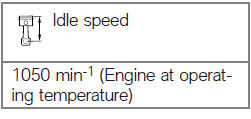
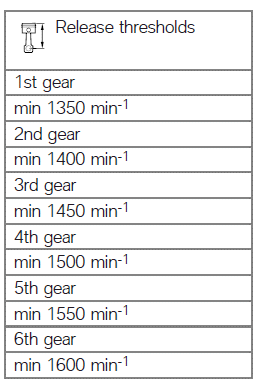
Hill Start Control
Hill Start Control function
The Hill Start Control prevents an uncontrolled rolling back on slopes by means of targeted intervention in the partial integral ABS brake system, without the rider having to continuously operate the brake lever. When Hill Start Control is activated, pressure builds in the rear brake system so that the motorcycle remains stationary on a sloping surface.
The brake pressure in the brake system depends on the gradient.
Influence of gradient on brake pressure and starting behavior
- Stopping on a slight incline builds up only a small amount of brake pressure. The brake is released quickly when driving off, making it possible to drive off more smoothly. Additional turning of the throttle grip is hardly necessary.
- Stopping on a steeper slope increases the amount of brake pressure built up. The brake is a bit slower to release when driving off. More torque is required to drive off, making additional turning of the throttle grip necessary.
Behavior when the vehicle is rolling or slipping
- The brake pressure increases when the vehicle is rolling with Hill Start Control active.
- If the rear wheel slips, the brake is released again after approx. 1 m. This prevents the vehicle from rolling with the rear wheel blocked.
Releasing the brake when switching off the engine or during timeout
Hill Start Control is deactivated when the engine is switched off using the emergency-off switch, when the side stand is folded out, or after it times out (10 minutes).
In addition to the indicator and warning lights, the rider is to be made aware about the deactivation of the Hill Start Control by the following behavior:
Brake warning jerk
- The brake is released briefly and is immediately reactivated.
- This causes a jerking behavior that the driver can feel.
- The partial integral ABS brake system sets a speed of approx.1-2 km/h.
- The driver must brake the vehicle manually.
- After two minutes, or when the brake is applied, Hill Start Control is deactivated completely.
NOTICE When the ignition is switched off, the holding pressure is built up immediately and without brake warning jerk.
See also:
 BMW R 1250 GS GSA - Rider's Manual > Riding mode
BMW R 1250 GS GSA - Rider's Manual > Riding mode
Selection In order to adjust the motorcycle to the road condition and the desired riding experience, it is possible to select one of the following riding modes: RAIN ROAD (standard mode)
 BMW R 1250 GS GSA - Rider's Manual > Maintenance
BMW R 1250 GS GSA - Rider's Manual > Maintenance
General notes The 'Maintenance' chapter describes work involving the checking and replacement of wear parts that can be performed with a minimum of effort.
 Rider's Manual BMW R 1250 GS GSA
Rider's Manual BMW R 1250 GS GSA Owner's Manual Harley-Davidson Sportster XL1200X Forty-Eight
Owner's Manual Harley-Davidson Sportster XL1200X Forty-Eight Owner's Manual Honda CBR650R
Owner's Manual Honda CBR650R Service manual Honda CBR650
Service manual Honda CBR650 Owner's Manual Honda PCX125
Owner's Manual Honda PCX125 Owner's Manual Kawasaki Z1000SX
Owner's Manual Kawasaki Z1000SX Service manual Kawasaki Z1000SX
Service manual Kawasaki Z1000SX Owner's Manual Lexmoto Echo
Owner's Manual Lexmoto Echo Owner's Manual Royal Enfield Interceptor 650
Owner's Manual Royal Enfield Interceptor 650 Service manual Royal Enfield Interceptor 650
Service manual Royal Enfield Interceptor 650 Owner's Manual Yamaha MT-07
Owner's Manual Yamaha MT-07